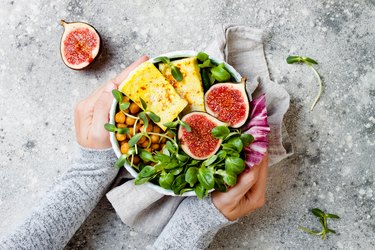
Eggs are a tasty, cheap and convenient way to add protein to your day. But if you're following a vegan diet or have an egg allergy, including them in your meal plan is just not an option.
Good news: There are many plant-based foods out there with more protein than an egg.
Video of the Day
Video of the Day
One large egg weighs about 1.76 ounces, or around 50 grams, and provides 6.3 grams of protein, per the USDA. But eating a variety of plant-based foods is a great way to get your daily dose of protein, as well as a range of vitamins and minerals, such as vitamin C, vitamin K and magnesium.
So yes, it is possible to get all the protein you need from plants!
And get this: We can only get certain nutrients from plants — such as dietary fiber and flavonoids — which give greens a leg up over eggs.
What's more, eating plant protein is associated with a lower risk of all-cause and heart disease mortality — and replacing foods high in animal protein with plant protein sources could be associated with longevity, per a July 2020 BMJ meta-analysis.
If you're giving a plant-forward diet a go, add these nine plant-based foods that have more protein than an egg to your daily routine.
1. Pistachios
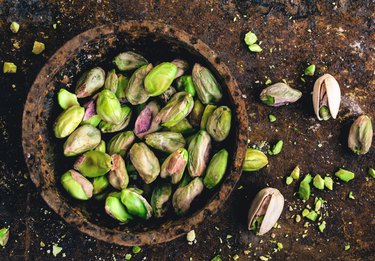
Protein per 1.76 ounces (about one-third cup): 10 grams
Pistachios are not only delicious, but they also pack a big punch of plant-based protein with more of the macro per gram than many other nuts.
You can get approximately 10 grams of protein from the egg-equivalent 1.76 ounces (about one-third cup of pistachios). A typical one-ounce serving (about one-quarter cup), still provides plenty of plant-based protein with 6 grams.
A wide variety of pistachios, including in-shell, plain, salted and chili-roasted, are readily available online, at the grocery store and in the food section of many pharmacies and drug stores. They're an excellent portable snack, making them an easy grab-and-go option to help fuel your day.
And here's the best part about in-shell pistachios: They have a built-in mindful eating solution.
Just the act of removing the pistachios from the shell may help us slow down and eat more mindfully as well as offer a visual cue regarding how much we've eaten, which can potentially reduce the number of calories we take in.
Brands We Love
- Wonderful Pistachios Roasted and Lightly Salted ($6.99, Amazon.com)
- Wonderful Pistachios Sweet Chili ($4.79, Amazon.com)
- Himalayan Harvest Pistachios ($9.99, Amazon.com)
2. Tofu
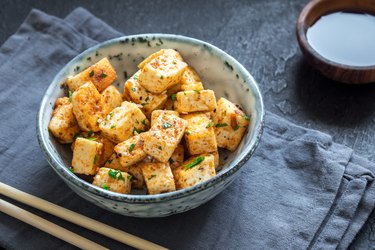
Protein per 1.76 ounces (about a one-fifth cup or 3 tablespoons): 8.7 grams
Tofu, a popular plant-based protein, is made from soybeans that are coagulated, strained and pressed in a process similar to how some cheeses are made.
Clocking in at 8.7 grams of plant-based protein per 1.76 ounces (or nearly 22 grams of protein per half-cup serving), this nutrient powerhouse also contains high levels of calcium, iron, B vitamins, fiber, potassium and magnesium.
Tofu has a fairly neutral taste, which lends itself easily to absorbing other flavors, making it an extremely versatile addition to any dish.
Silken tofu is a great plant-based substitute that adds creaminess (without the saturated fat that comes with cream) to soups, smoothies and desserts. Baked tofu is another great way to add plant-based protein to your meal rotation.
Dice and marinate extra firm tofu in a mixture of olive oil, balsamic vinegar and Mediterranean spices such as thyme, oregano and red pepper flakes before baking and then pop it in the oven until it crisps up.
We guarantee this dish will convert even the most committed anti-tofu eater!
Brands We Love
- House Foods Extra-Firm Tofu ($1.43, Amazon.com)
- 365 Everyday Value Organic Silken Tofu ($1.99, Amazon.com)
3. Oats
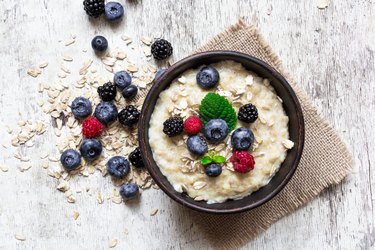
Protein per 1.76 ounces (one-third cup): 8.5 grams
Nutrient-dense oats are rich in plant-based protein, fiber, magnesium and zinc.
Just 1.76 ounces of uncooked oats, or roughly one-third cup, contains 8.5 grams of protein. In addition to their solid protein content, oats are linked to controlling hyperglycemia, lowering blood lipids and reducing weight, per a September 2016 study in Nutrients.
Not sure which oats to try? Steel-cut oats boast a chewy texture and require a longer cooking time, while old-fashioned oats and quick oats are rolled thin, and therefore have a softer consistency and require less time to prepare.
To help cut down on weekday cooking time, make a big batch of oats and portion it out for the week. Just grab a container out of the fridge, throw it in the microwave and add your favorite toppings (we like frozen fruit, unsweetened coconut shreds and cacao nibs).
Steel-cut, rolled and quick oats are all 100-percent whole grains, and have similar fiber and nutrients ounce per ounce so no need for any nutrient FOMO — you still get them all!
Brands We Love
- Quaker Oats Old Fashioned 100% Whole Grain Oats ($2.36, Amazon.com)
- McCann's Steel Cut Oatmeal ($31.16, Amazon.com)
4. Spirulina Algae

Protein per 1.76 ounces (nearly one-half cup): 28.8 grams
"Spirulina algae is most often considered a supplement, taken in dehydrated 'pellet' form — aka, a pill — or as a powder that can be added to beverages, such as smoothies or even a plant-based milk alternative," Kelly Jones, RD, CSSD, a Philadelphia-based sports dietitian, tells LIVESTRONG.com.
While a 1.76-ounce portion would be fairly large (nearly half a cup), it contains 28 grams of high-quality plant protein, as well as 400 milligrams of omega-3s, 80 percent of the daily value of iron as well as a variety of B vitamins and other minerals.
It may be more realistic to add 2 tablespoons to a smoothie for a 7-gram protein boost, Jones says.
Be sure to store spirulina in the refrigerator so that it stays fresh. In addition to smoothies, the blue-green algae also meshes well with chocolate in homemade foods, including energy balls or brownies, and can be found in a variety of food products, such as energy and protein bars.
Brands We Love
- Ancestral Roots Organic Spirulina Powder ($8.99, Amazon.com)
- BN Labs Organic Spirulina Powder ($12.99, Amazon.com)
5. Lupini Beans
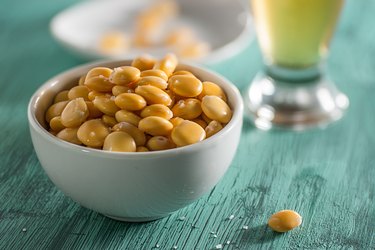
Protein per 1.76 ounces (one-third cup): 7.8 grams
Lupini beans, also known as lupin beans, are legumes that belong to the same family as peanuts. This nutritionally rich bean boasts 7.8 grams of plant-based protein per 1.76 ounces (or about one-third cup cooked), and nearly 13 grams per half a cup.
In addition to delivering a decent amount of plant-based protein, snacking on lupini beans regularly is linked to lower blood pressure, improved insulin sensitivity and positively altering the good bacteria in our gut, according to a September 2016 study in the Asia Pacific Journal of Clinical Nutrition.
Chef and dietitian Julie Harrington, RD, recommends lupini beans because "they offer a combination of both protein and fiber. Most of us don't eat enough fiber, and eating more beans is a good place to start."
Lupini beans are often packed in brine or marinated, similar to pickles and olives, and are readily available in your local grocery store's pantry aisle or at big-box retailers such as Walmart and Costco.
Try adding them to salads, serving them as part of an antipasti plate or grabbing a handful for an afternoon snack.
Brands We Love
- Brami Snacking Lupini Beans ($9.44, Amazon.com)
- Cento Lupini Beans ($23.99, Amazon.com)
6. Hemp Seeds
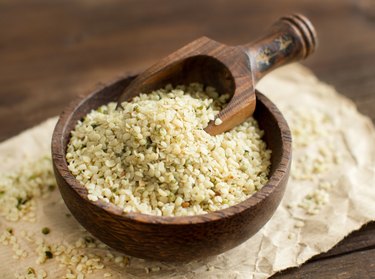
Protein per 1.76 ounces (about 5 tablespoons): 15.8 grams
While hemp seeds, which come from the hemp plant, aren't psychoactive, they pack a serious protein punch. They also add a nutty crunch to salads and are a good source of omega-3s, as well as phosphorous, iron and magnesium.
While 1.76 ounces (slightly more than 5 tablespoons) of these seeds can get you a whopping 15.8 grams of protein, adding just one 3-tablespoon serving (or roughly 1 ounce) to your morning smoothie will get you 9.5 grams of plant-based protein and 20 percent of the daily value for iron.
"I recommend adding them to meals and snacks, especially due to their iron content — a nutrient that most women and children should be paying attention to," Jones says.
A Brand We Love
Manitoba Harvest Shelled Hemp Seeds ($4.64, Amazon.com)
7. Wheat Germ
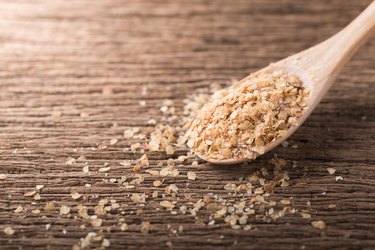
Protein per 1.76 ounces (4 tablespoons): 14.6 grams
Wheat germ is actually the part of wheat that sprouts and grows into a new plant, and it's frequently used to add nutrients, flavor and texture to foods.
While 1.76 ounces (nearly 4 tablespoons) contains 14.6 grams of protein, a more realistic 2-tablespoon serving clocks in at more than 8 grams of plant-based protein.
One serving of the delightfully nutty, golden nugget also provides fiber, folate, magnesium, zinc and vitamin E.
Keep wheat germ in the refrigerator to maintain its freshness. It goes well in everything from muffins to meatloaf to smoothies.
When baking with wheat germ, swap out one-half cup of flour and replace it with one-half cup of wheat germ. Or, sprinkle it on yogurt or use it in place of breadcrumbs for added flavor and a nutrient boost.
Brands We Love
- Bob’s Red Mill Wheat Germ ($19.97, Amazon.com)
- Kretschmer Original Toasted Wheat Germ ($23.50, Amazon.com)
8. Pumpkin Seeds
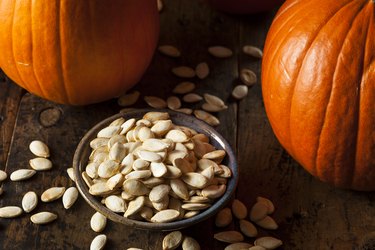
Protein per 1.76 ounces (7 tablespoons): 15.1 grams
Pumpkin seeds are just delicious as their sweet flesh that makes for a great roasted side dish.
When roasted, these tiny trophies have a delectable crunch. You can get more than 15 grams of protein from the egg-equivalent 1.76 ounces (nearly 7 tablespoons).
A typical 1-ounce serving, or slightly less than 4 tablespoons, still provides a good amount of plant-based protein with 8.5 grams.
Tip
Add pumpkin seeds to a food processor along with some cilantro, olive oil, salt and pepper for a variation on pesto.
You can find raw and toasted pumpkin seeds, also known as pepitas, in most grocery stores. You can also carve a pumpkin, dig out these edible nuggets and roast them yourself.
They're equally fantastic served salty or sweet, and make great salad toppers and snacks.
Brands We Love
- SuperSeedz Gourmet Pumpkin Seeds ($25.87, Amazon.com)
- I’m a Nut Raw Pumpkin Seeds ($25, Amazon.com)
9. Peanut Butter
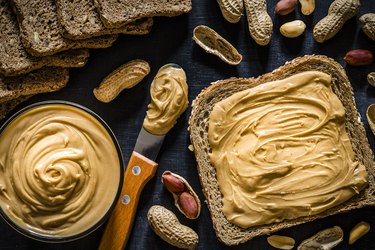
Protein per 1.76 ounces (about 3 tablespoons): 12.4 grams
And now for an all-time favorite, it's good ol' peanut butter.
"Ounce per ounce, peanut butter has more protein than an egg," dietitian and certified personal trainer Nicole Rodriguez, RDN, NASM-CPT, tells us. The 1.76-ounce egg-equivalent provides nearly 13 grams of protein, while the recommended 2-tablespoon serving delivers 7 grams of plant-based protein.
"While PB is also known for packing in healthy, monounsaturated, a serving also provides about 3 grams of fiber." What's more, peanuts are linked to having disease-protecting properties and promoting longevity, per a January 2016 study in the Journal of Food Science and Technology.
Indulgences aside, peanut butter goes great with fruits and vegetables, like sliced apples and celery sticks. You can also stir some into oatmeal, add a dollop to yogurt or add a couple of tablespoons into your smoothie.
To get the most nutritional bang for your buck, Rodriguez recommends looking for varieties with only one ingredient — peanuts (and maybe a dash of salt).
Brands We Love
- Crazy Richard’s Peanut Butter ($2.94, Amazon.com)
- Teddie All-Natural Peanut Butter ($13.29 per 3-pack, Amazon.com)
- Nutrients: “Short- and Long-Term Effects of Wholegrain Oat Intake on Weight Management and Glucolipid Metabolism in Overweight Type-2 Diabetics: A Randomized Control Trial”
- Public Library of Science Medicine: “Whole Grain, Bran, and Germ Intake and Risk of Type 2 Diabetes: A Prospective Cohort Study and Systematic Review”
- Asia Pacific Journal of Clinical Nutrition: “Health Benefits of Legumes and Pulses with a Focus on Australian Sweet Lupins”
- Journal of Food Science and Technology: “Peanuts as Functional Food: A Review”
- USDA: "Egg"
- USDA: "Uncooked Oats"
- USDA: "Dried Spirulina Seaweed"
- USDA: "Firm Tofu"
- USDA: "Lupini Beans (Cooked)"
- USDA: "Hemp Seeds"
- USDA: "Toasted Wheat Germ"
- USDA: "Pumpkin Seeds (pepitas)"
- USDA: "Peanut Butter"
- BMJ: "Dietary intake of total, animal, and plant proteins and risk of all cause, cardiovascular, and cancer mortality: systematic review and dose-response meta-analysis of prospective cohort studies"